The crew on board the International Space Station heard a strange sound again on Friday; the second time in four months. Alexander Kaleri was speaking with flight controllers when he heard a loud, drumlike sound coming from an instrument panel. Kaleri and Michael Foale searched for the source of the sound last time, but they weren’t able to locate it. A spacewalk outside the station was called short because of a suit malfunction before the astronauts were able to see if there was a problem on the outside of the station. Kaleri and Foale are expected to return to Earth in just a few more weeks.
Andromeda’s Carnage
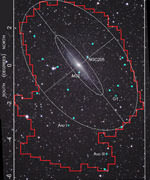
Image credit: RAS
An international team of astronomers has used the UK’s 2.5-m Isaac Newton Telescope on La Palma in the Canary Islands to map the Andromeda Galaxy (otherwise known as M31) and a large area of sky all around it. Their work over the last few years has created the most detailed image of a large spiral galaxy that currently exists. Dr Mike Irwin of the University of Cambridge, one of the team leaders, reports on some of the latest findings on Wednesday 31 March, when he will tell the RAS National Astronomy Meeting at the Open University about the first clear evidence that M31 is pulling one of its bright satellite galaxies apart, and the discovery of 14 previously unknown globular clusters orbiting far from the centre of M31 which could have been left behind when Andromeda devoured their parent galaxies.
Located around 2.5 million light years away, the Andromeda Galaxy is the most distant object visible to the naked eye, and is considered to be the sister galaxy of our own Milky Way. By studying this galactic neighbour, astronomers hope to understand more about the formation and evolution of many of the billions of spiral galaxies in the universe, including the Milky Way.
For their survey, the team have taken 150 individual images with a sensitive electronic CCD camera, which reveal millions of individual stars. It extends over an area 100 times greater than all earlier studies combined. The reason for scanning such a large area is that. around bright galaxies. there is a tenuous “halo” of stars which are leftovers from the formation of the galaxy billions of years ago. Studying this “fossil” information reveals evidence for how the halo, and hence the rest of the galaxy, has built up over cosmic history.
Traditionally, galaxy halos were thought to be relatively smooth and devoid of substructure. In fact the new survey shows that Andromeda’s halo is the exact opposite: it has a wealth of structure, indicating that it has ripped apart smaller galaxies that came too close and that the halo is built up from their remains. “Given that the disk of Andromeda appears so pristine, we were shocked to discover that its halo shows so much evidence for a history of interactions with other galaxies,” says Mike Irwin.
At this year’s National Astronomy Meeting, the Andromeda team report the discovery of a large stream of stars which appears to have been pulled out of one of Andromeda’s well-known satellite galaxies, NGC205. The visible part of the apparent stream extends nearly 50,000 light years from the main body of this small elliptical galaxy and was previously unknown despite the fact that NGC 205 has been well-studied.
“This is the first clear indication that one of Andromeda’s companion galaxies is being ripped apart as we watch,” commented team member Alan McConnachie, a doctoral student at Cambridge.
The 14 globular clusters the team has found orbiting far out from M31 may be evidence of Andromeda’s past cannibalism. Globular clusters are ancient systems of hundreds of thousands of stars, which are seen around many galaxies, and provide many clues to their evolutionary history. “Since the most distant of these globular clusters is some 250,000 light years from the centre of M31, our work shows that M31’s halo extends far beyond the edge of the bright part of the galaxy disk,” said Avon Huxor of the University of Hertfordshire.
“Both these discoveries will greatly aid in understanding the evolution of these nearby galaxies and should shed light on how our own Galaxy became what it is today,” commented Nial Tanvir, another team member from the University of Hertfordshire.
Original Source: RAS News Release
Milky Way’s Centre Measured
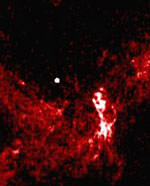
Image credit: NRAO
Thirty years after astronomers discovered the mysterious object at the exact center of our Milky Way Galaxy, an international team of scientists has finally succeeded in directly measuring the size of that object, which surrounds a black hole nearly four million times more massive than the Sun. This is the closest telescopic approach to a black hole so far and puts a major frontier of astrophysics within reach of future observations. The scientists used the National Science Foundation’s Very Long Baseline Array (VLBA) radio telescope to make the breakthrough.
“This is a big step forward,” said Geoffrey Bower, of the University of California-Berkeley. “This is something that people have wanted to do for 30 years,” since the Galactic center object, called Sagittarius A* (pronounced “A-star”), was discovered in 1974. The astronomers reported their research in the April 1 edition of Science Express.
“Now we have a size for the object, but the mystery about its exact nature still remains,” Bower added. The next step, he explained, is to learn its shape, “so we can tell if it is jets, a thin disk, or a spherical cloud.”
The Milky Way’s center, 26,000 light-years from Earth, is obscured by dust, so visible-light telescopes cannot study the object. While radio waves from the Galaxy’s central region can penetrate the dust, they are scattered by turbulent charged plasma in the space along the line of sight to Earth. This scattering had frustrated earlier attempts to measure the size of the central object, just as fog blurs the glare of distant lighthouses.
“After 30 years, radio telescopes finally have lifted the fog and we can see what is going on,” said Heino Falcke, of the Westerbork Radio Observatory in the Netherlands, another member of the research team.
The bright, radio-emitting object would fit neatly just inside the path of the Earth’s orbit around the Sun, the astronomers said. The black hole itself, they calculate, is about 14 million miles across, and would fit easily inside the orbit of Mercury. Black holes are concentrations of matter so dense that not even light can escape their powerful gravity.
The new VLBA observations provided astronomers their best look yet at a black hole system. “We are much closer to seeing the effects of a black hole on its environment here than anywhere else,” Bower said.
The Milky Way’s central black hole, like its more-massive cousins in more-active galactic nuclei, is believed to be drawing in material from its surroundings, and in the process powering the emission of the radio waves. While the new VLBA observations have not provided a final answer on the nature of this process, they have helped rule out some theories, Bower said. Based on the latest work, he explained, the top remaining theories for the nature of the radio- emitting object are jets of subatomic particles, similar to those seen in radio galaxies; and some theories involving matter being accelerated near the edge of the black hole.
As the astronomers studied Sagittarius A* at higher and higher radio frequencies, the apparent size of the object became smaller. This fact, too, Bower said, helped rule out some ideas of the object’s nature. The decrease in observed size with increasing frequency, or shorter wavelength, also gives the astronomers a tantalizing target.
“We think we can eventually observe at short enough wavelengths that we will see a cutoff when we reach the size of the black hole itself,” Bower said. In addition, he said, “in future observations, we hope to see a ‘shadow’ cast by a gravitational lensing effect of the very strong gravity of the black hole.”
In 2000, Falcke and his colleagues proposed such an observation on theoretical grounds, and it now seems feasible. “Imaging the shadow of the black hole’s event horizon is now within our reach, if we work hard enough in the coming years,” Falcke added.
Another conclusion the scientists reached is that “the total mass of the black hole is very concentrated,” according to Bower. The new VLBA observations provide, he said, the “most precise localization of the mass of a supermassive black hole ever.” The precision of these observations allows the scientists to say that a mass of at least 40,000 Suns has to reside in a space corresponding to the size of the Earth’s orbit. However, that figure represents only a lower limit on the mass. Most likely, the scientists believe, all the black hole’s mass — equal to four million Suns — is concentrated well inside the area engulfed by the radio-emitting object.
To make their measurement, the astronomers had to go to painstaking lengths to circumvent the scattering effect of the plasma “fog” between Sagittarius A* and Earth. “We had to push our technique really hard,” Bower said.
Bower likened the task to “trying to see your yellow rubber duckie through the frosted glass of the shower stall.” By making many observations, only keeping the highest-quality data, and mathematically removing the scattering effect of the plasma, the scientists succeeded in making the first-ever measurement of Sagittarius A*’s size.
In addition to Bower and Falcke, the research team includes Robin Herrnstein of Columbia University, Jun-Hui Zhao of the Harvard-Smithsonian Center for Astrophysics, Miller Goss of the National Radio Astronomy Observatory, and Donald Backer of the University of California-Berkeley. Falcke also is an adjunct professor at the University of Nijmegen and a visiting scientist at the Max-Planck Institute for Radioastronomy in Bonn, Germany.
Sagittarius A* was discovered in February of 1974 by Bruce Balick, now at the University of Washington, and Robert Brown, now director of the National Astronomy and Ionospheric Center at Cornell University. It has been shown conclusively to be the center of the Milky Way, around which the rest of the Galaxy rotates. In 1999, Mark Reid of the Harvard-Smithsonian Center for Astrophysics and his colleagues used VLBA observations of Sagittarius A* to detect the Earth’s motion in orbit around the Galaxy’s center and determined that our Solar System takes 226 million years to make one circuit around the Galaxy.
In March 2004, 55 astronomers gathered at the National Radio Astronomy Observatory facility in Green Bank, West Virginia, for a scientific conference celebrating the discovery of Sagittarius A* at Green Bank 30 years ago. At this conference, the scientists unveiled a commemorative plaque on one of the discovery telescopes.
The Very Long Baseline Array, part of the National Radio Astronomy Observatory, is a continent-wide radio-telescope system, with 10, 240-ton dish antennas ranging from Hawaii to the Caribbean. It provides the greatest resolving power, or ability to see fine detail, of any telescope in astronomy, on Earth or in space.
The National Radio Astronomy Observatory is a facility of the National Science Foundation, operated under cooperative agreement by Associated Universities, Inc.
Original Source: NRAO News Release
Spirit Finds Hints of Past Martian Water
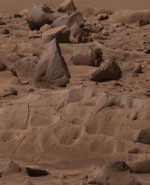
Image credit: NASA/JPL
Clues from a wind-scalloped volcanic rock on Mars investigated by NASA’s Spirit rover suggest repeated possible exposures to water inside Gusev Crater, scientists said Thursday.
Gusev is halfway around the planet from the Meridiani region where Spirit’s twin, Opportunity, recently found evidence that water used to flow across the surface.
“This is not water that sloshed around on the surface like what appears to have happened at Meridiani. We’re talking about small amounts of water, perhaps underground,” said Dr. Hap McSween, a rover science team member from the University of Tennessee, Knoxville.
“The evidence is in the form of multiple coatings on the rock, as well as fractures that are filled with alteration material and perhaps little patches of alteration material,” McSween said during a press conference at NASA’s Jet Propulsion Laboratory, Pasadena, Calif.
The rock, called “Mazatzal” after mountains in Arizona, lies partially buried near the rim of the crater informally named “Bonneville” inside the much larger Gusev Crater. Its light- toned appearance grabbed scientists’ attention. After Spirit’s rock abrasion tool brushed two patches on the surface with wire bristles, a gray, darker layer could be seen under the tan topcoat. The rock abrasion tool ground into the surface with diamond cutting teeth on March 26. Then, after an examination of the newly exposed material, it ground deeper into the rock two days later. A lighter-gray interior lies under the darker layer, and a bright stripe cuts across both.
Dr. Jeff Johnson, a science team member from the U.S. Geological Survey’s Astrogeology Team, Flagstaff, Ariz., said the stripe “seems to be a fracture that water has flowed through, potentially with minerals precipitating from that fluid and lining the walls of the crack.”
He and other scientists stressed that the interpretations are preliminary. “The team is, as always, trying to find time to digest these observations while also preparing for the next day’s operations,” Johnson said.
Spirit’s alpha particle X-ray spectrometer checked what chemical elements were close to the surface of untreated, brushed, once-drilled and twice-drilled patches. “Miracles, miracles, miracles. We have a lot of work to do,” the instrument’s lead scientist, Dr. Rudi Rieder of the Max Planck Institute, Mainz, Germany, exclaimed about the results. For example, the ratio of bromine to chlorine seen inside the rock is unusually high and possibly a clue to alteration by water.
The final experiment on Mazatzal was to scrub the surface with the rock abrasion tool in a pattern of five circles arranged in a ring, with a sixth circle in the center. Besides creating a rock-art daisy, this task by the engineers of New York-based Honeybee Robotics, as well as JPL, produced a brushed patch big enough to fill the field of view of Spirit’s miniature thermal emission spectrometer, said Dr. Steve Ruff of Arizona State University, Tempe. The tan outer surface appears to have a strikingly different mineral composition than the dark gray coating exposed by the brushing, but more time is needed to complete the analysis, he said.
McSween proposed that the light outer coat, dark inner coat and bright veins could have resulted from three different periods of the rock being buried, altered by fluids and unburied.
While scientists await transmission of additional data Spirit has collected about Mazatzal, the rover will be making its way toward the “Columbia Hills” about 2.3 kilometers (1.3 miles) away. Spirit left the rock and drove 36.5 meters (120 feet) early Thursday.
Opportunity set a one-day driving record on Mars on March 27 by covering 48.9 meters (160 feet) toward a rock called “Bounce Rock” because airbag bounce marks show that the spacecraft hit it on landing day two months ago. “We’re looking to break that record again very soon with longer and longer drives,” said JPL’s Chris Lewicki, flight director.
Before moving on across the plains of Meridiani, though, Opportunity will complete an investigation it has begun of Bounce Rock. The rock is unlike any seen on Mars before, said Dr. Jim Bell, lead scientist for the rovers’ panoramic cameras. “There are some shiny surfaces on this rock,” he said, describing them as “almost mirrorlike.”
The two rovers’ 18 cameras have now taken more than 20,000 images. JPL, a division of the California Institute of Technology in Pasadena, manages the Mars Exploration Rover project for NASA’s Office of Space Science, Washington, D.C.
Images and additional information about the project are available from JPL at http://marsrovers.jpl.nasa.gov and from Cornell University, Ithaca, N.Y., at http://athena.cornell.edu .
Original Source: NASA/JPL News Release
Gravity Probe B Launch in Two Weeks
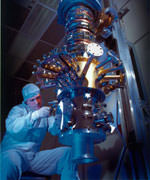
Image credit: Stanford
A NASA spacecraft designed to test two important predictions of Albert Einstein’s general theory of relativity is set to launch from Vandenberg Air Force Base, Calif., at 1 p.m. EDT, April 17.
NASA’s Gravity Probe B mission, also known as GP-B, will use four ultra-precise gyroscopes, orbiting the Earth in a unique satellite, to experimentally test two extraordinary predictions of Einstein’s 1916 theory that space and time are distorted by the presence of massive objects. The two effects being tested are: The geodetic effect, the amount by which the Earth warps local spacetime in which it resides, and the frame-dragging effect, the amount by which the Earth drags local spacetime around with it as it rotates.
“Gravity Probe-B has the potential to uncover fundamental properties of the invisible universe, a universe which seems very bizarre and alien to our everyday perceptions yet one that Einstein tried to show us almost a century ago,” said Dr. Anne Kinney, director of the Astronomy and Physics Division in NASA’s Office of Space Science, Washington. “Testing the key aspects of Einstein’s theory, such as GP-B will do, will provide crucial information to science just as it has already helped America by pushing technological progress in developing the tools needed for these ultra-precise measurements,” she added
Once placed in its polar orbit of 640 kilometers (400 miles) above Earth, GP-B will circle the globe every 97.5 minutes, crossing over both poles. In-orbit checkout and calibration is scheduled to last 40-60 days, followed by a 13-month science-data acquisition period and a two-month post-science period for calibrations.
To test the general theory of relativity, GP-B will monitor any drift in the gyroscopes’ spin axis alignment in relation to its guide star, IM Pegasi (HR 8703). Over the course of a year, the anticipated spin axis drift for the geodetic effect is a minuscule angle of 6,614.4 milliarcseconds, and the anticipated spin axis drift for the frame-dragging effect is even smaller, only 40.9 milliarcseconds. To illustrate the size of the angles, if you climbed a slope of 40.9 milliarcseconds for 100 miles, you would rise only one inch in altitude.
During the mission, data from GP-B will be received a minimum of two times each day. Earth-based ground stations or NASA’s data relay satellites can receive the information. Controllers will be able to communicate with GP-B from the Mission Operations Center at Stanford University.
Data will include space vehicle and instrument performance, as well as the very precise measurements of the gyroscopes’ spin-axis orientation. By 2005 the GP-B mission will be complete, and a one-year period is planned for scientific analysis of the data.
“Developing GP-B has been a supreme challenge requiring the skillful integration of an extraordinary range of new technologies,” said Professor Francis Everitt of Stanford University, and the GP-B principal investigator. “It is hard to see how it could have been done without the kind of unique long-term collaboration that we have had between Stanford, Lockheed Martin, and NASA. It is wonderful to be ready for launch,” he said.
NASA’s Marshall Space Flight Center, Huntsville, Ala., manages the GP-B program. NASA’s prime contractor for the mission, Stanford University, conceived the experiment and is responsible for the design and integration of the science instrument, as well as for mission operations and data analysis. Lockheed Martin, a major subcontractor, designed, integrated and tested the spacecraft and some of its major payload components. NASA’s Kennedy Space Center, Fla., and Boeing Expendable Launch Systems, Huntington Beach, Calif., are responsible for the countdown and launch of the Delta II.
The launch from Vandenberg will be broadcast live on NASA Television on the AMC-9 satellite, transponder 9C, located at 85 degrees West longitude, vertical polarization, frequency 3880.megahertz, audio 6.8 megahertz. Information about launch events and video will be carried on a NASA website called the Virtual Launch Control Center at:
http://www.ksc.nasa.gov/elvnew/gpb/vlcc.htm
For information about the GP-B mission on the Internet, visit:
and
Original Source: NASA News Release
Wallpaper: Getting Closer to Saturn
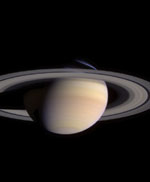
Image credit: CICLOPS
As Cassini closes in on Saturn, its view is growing sharper with time and now reveals new atmospheric features in the planet’s southern hemisphere.
The spacecraft’s narrow angle camera took several exposures on March 8, 2004 which have been combined to create this natural color image. The image contrast and colors have been slightly enhanced to aid visibility. The spacecraft was then 56.4 million kilometers (35 million miles) from Saturn, or slightly more than one-third of the distance from Earth to the Sun. The image scale is approximately 338 kilometers (210 miles) per pixel. The planet is 23 percent larger in this image than it appeared in the preceding color image, taken four weeks earlier.
Atmospheric features such as two small, faint dark spots, visible in the planet’s southern hemisphere, will become clearer in the coming months. The spots are located at 38 degrees South latitude.
Moons visible in the lower half of this image: Mimas (398 kilometers, 247 miles across) at left, just below the rings; Dione (1,118 kilometers, 695 miles across) at left, below Mimas; and Enceladus (499 kilometers, 310 miles across) at right. The moons have had their brightness enhanced to aid visibility.
The Cassini-Huygens mission is a cooperative project of NASA, the European Space Agency and the Italian Space Agency. The Jet Propulsion Laboratory, a division of the California Institute of Technology in Pasadena, manages the Cassini-Huygens mission for NASA’s Office of Space Science, Washington, D.C. The imaging team is based at the Space Science Institute, Boulder, Colorado.
For more information about the Cassini-Huygens mission, visit http://saturn.jpl.nasa.gov and the Cassini imaging team home page, http://ciclops.org.
Original Source: CICLOPS News Release
Solar Plane Will Attempt to Go Around the Earth
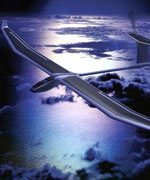
Image credit: ESA
ESA’s Technology Transfer Programme is to supply state-of-the-art technologies to assist adventurer Bertrand Piccard’s flight around the world in a single-pilot solar-powered aircraft, as the ultimate demonstration of the potential for pollution-free flight.
Back in 1999 Piccard and co-pilot Brian Jones were the first people to balloon around the world non-stop. Piccard has now launched Solar Impulse to repeat his global circumnavigation, this time in a pollution-free solar-powered aircraft.
This ambitious project is being presented at the ’32nd International Exhibition of Inventions, New Techniques and Products’ to open in Geneva, Switzerland, this week.
The proposed aircraft resembles a glider, but with a mammoth 70-metre wingspan, exceeding that of a Boeing 747. Completely covered by solar cells and equipped with possibly two tail-mounted propeller engines, the plane will be capable of unassisted take-off and will carry the necessary batteries for night flying.
Several domains have already been identified where European space expertise could provide leading-edge technologies: they include batteries and solar cells, energy management systems, ultra-light composite structures and monitoring systems to check the health of the pilot.
The sky’s the limit for sustainable development
For the Solar Impulse project, Piccard is again teaming up with Brian Jones, his co-pilot aboard the record-breaking Breitling Orbiter 3 balloon five years ago. He has appointed engineer and pilot Andr? Borschberg as project manager and third pilot of the team.
“The challenge this time is to influence the history of air transportation by exploiting new technologies that satisfy the demands of our era for sustainable development and the use of only renewable forms of energy,” Piccard explains.
ESA’s Technology Transfer Programme is providing technological support while the Swiss Federal Institute of Technology (EPFL) in Lausanne is the ‘Official Scientific Advisor’ of the project.
“The primary source of energy on our satellites is the Sun, as for Piccard’s plane,” says Pierre Brisson, Head of ESA’s Technology Transfer Programme. “We have developed some of the world’s best solar cells and advanced energy storage and power management systems, all key technologies onboard our spacecraft. They will be a good starting point for Piccard’s effort.”
The EPFL institute has just completed a feasibility study for the project analysing existing technologies. Yves Perriard, director of EPFL Integrated Actuators Laboratory and one of the lead scientists of the study, confirmed: “We know that it is possible to create a structure completely powered by the Sun.” EPFL was an obvious choice for this study. The institute conducted the thermodynamic research for the successful Piccard-Jones 1999 balloon flight and is the official scientific advisor to the Swiss Alinghi sailing team, current holder of the American Cup.
100% solar powered at 10 km altitude, flying round the clock
The Solar Impulse solar-powered aeroplane must keep above the clouds to capture all available sunlight, at an altitude of 10 000 to 11 000 metres, where the temperature is around ?55?C.
Its cockpit may have to be pressurised for longer missions and its construction will require the use of the latest technologies in ultra-light materials. The most important challenge will be to build the large aeroplane with a very lightweight structure capable of carrying sufficient batteries for night flight.
The electrical requirements pose another key engineering challenge ? how to store sufficient solar power during the day to continue the flight throughout the night.
Perriard explains: “It is really a war against all the losses in the power system from solar cells to the motors.”
The EPFL study says that current off-the-shelf lithium-ion batteries provide just under 200 watt-hours per kilogram (Wh/kg), enough to support a single-pilot plane, while a two-pilot solution would require a capacity of at least 300 Wh/kg.
The plan is to design and construct the first prototype aircraft in 2004-2005, with initial test flights in 2006. The next step is to complete night flights in 2007, initially at least 36 hours including one full night. From then on flying lengths are to be increased. . Innovative solutions will be required to store the necessary food and water while reduce weight to a minimum ? familiar problems for ESA engineers designing space missions.
When will the Solar Impulse fly around the world, non-stop? “It is planned to cross the Atlantic in 2008 and fly around the world with stop-overs in 2009,” says Andr? Borschberg, “To fly around non-stop depends very much on how quickly we will have higher energy density batteries?but not before 2009.”
Original Source: ESA News Release
How Many Habitable Earths Are Out There?

Image credit: NASA
More than 100 planetary systems have already been discovered around distant stars. Unfortunately, the limitations of current technology mean that only giant planets (like Jupiter) have so far been detected, and smaller, rocky planets similar to Earth remain out of sight.
How many of the known exoplanetary systems might contain habitable Earth-type planets? Perhaps half of them, according to a team from the Open University, led by Professor Barrie Jones, who will be describing their results today at the RAS National Astronomy Meeting in Milton Keynes.
By using computer modelling of the known exoplanetary systems, the group has been able to calculate the likelihood of any ‘Earths’ existing in the so-called habitable zone – the range of distances from each central star where life as we know it could survive. Popularly known as the “Goldilocks” zone, this region would be neither too hot for liquid water, nor too cold.
By launching ‘Earths’ (with masses between 0.1 and 10 times that of our Earth) into a variety of orbits in the habitable zone and following their progress with the computer model, the small planets have been found to suffer a variety of fates. In some systems the proximity of one or more Jupiter-like planets results in gravitational ejection of the ‘Earth’ from anywhere in the habitable zone. However, in other cases there are safe havens in parts of the habitable zone, and in the remainder the entire zone is a safe haven.
Nine of the known exoplanetary systems have been investigated in detail using this technique, enabling the team to derive the basic rules that determine the habitability of the remaining ninety or so systems.
The analysis shows that about half of the known exoplanetary systems could have an ‘Earth’ which is currently orbiting in at least part of the habitable zone, and which has been in this zone for at least one billion years. This period of time has been selected since it is thought to be the minimum required for life to arise and establish itself.
Furthermore, the models show that life could develop at some time in about two thirds of the systems, since the habitable zone moves outwards as the central star ages and becomes more active.
Habitable Moons
A different aspect of this problem is being studied by PhD student David Underwood, who is investigating the possibility that Earth-sized moons orbiting giant planets could support life. A poster setting out the possibilities will be presented during the RAS National Astronomy Meeting.
All of the planets discovered so far are of similar mass to Jupiter, the largest planet in our Solar System. Just as Jupiter has four planet-sized moons, so giant planets around other stars may also have extensive satellite systems, possibly with moons similar in size and mass to Earth.
Life as we know it cannot evolve on a gaseous, giant planet. However, it could survive on Earth-sized satellites orbiting such a planet if the giant is located in the habitable zone.
In order to determine which of the gas giants located within habitable zones could possess a life-friendly moon, the computer models search for systems where the orbits of Earth-sized satellites would be stable and confined within the habitable zone for at least the one billion years needed for life to emerge.
The OU team’s method of determining whether any putative ‘Earths’ or Earth-sized satellites in habitable zones can offer suitable conditions for life to evolve can be applied rapidly to any planetary systems that are newly announced. Future searches for ‘Earths’ and extraterrestrial life should also be assisted by identifying in advance the systems most likely to house habitable worlds.
The predictions made by the simulations will have a practical value in years to come when next-generation instruments will be able to search for the atmospheric signatures of life, such as large amounts of oxygen, on ‘Earths’ and Earth-sized satellites.
Background
There are currently 105 known planetary systems other than our own, with 120 Jupiter-like planets orbiting them. Two of these systems contain three known planets, 11 contain two and the remaining 92 each have one. All but one of these planets has been discovered by their effect on their parent stars’ motion in the sky, causing them to wobble regularly. The extent of these wobbles can be determined from information within the light received from the stars. The remaining planet was discovered as the result of a slight dimming of starlight caused by its regular passage across the disk of its parent star.
Future discoveries are likely to contain a higher proportion of systems that resemble our Solar System, where the giant planets orbit at a safe distance beyond the habitable zone. The proportion of systems that could have habitable ‘Earths’ is, therefore, likely to rise. By the middle of the next decade, space telescopes should be capable of seeing any ‘Earths’ and investigating them to see if they are habitable, and, indeed, whether they actually support life.
Original Source: RAS News Release
Astronomers Discover Mini-Galaxies
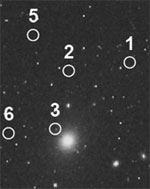
Image credit: Steve Phillipps
A new survey made with the Anglo-Australian Telescope (AAT) has revealed dozens of previously unsuspected miniature galaxies in the nearby Fornax galaxy cluster. They belong to a class of galaxies dubbed “ultra-compact dwarfs” (UCDs), which was unknown before the same team of astronomers discovered 6 of them in the Fornax cluster in 2000. Now they say the UCDs outnumber the “conventional” elliptical and spiral galaxies in the central region of the Fornax cluster and they have found some in the Virgo galaxy cluster too. It is possible that at least some are left-over examples of the primordial “building blocks” that formed large galaxies by merging together. It is likely that they are very common but have been overlooked because they resemble nearby stars at first sight. These results will be presented to the RAS National Astronomy Meeting at the Open University on Thursday 1 April by Dr Steven Phillips of Bristol University.
UCDs were discovered by chance when Dr Phillipps and his colleagues undertook a large survey of all the moderately bright objects they could see in the direction of the Fornax cluster. Only because they used a spectrograph (the Two Degree Field, or 2dF, system on the AAT) were they able to measure redshifts, which told them that 6 objects looking like local stars in our Galaxy were in fact in the Fornax cluster about 60 million light years away. Follow-up observations with the Hubble space Telescope and the European Southern Obervatory’s Very Large Telescope (VLT) revealed just how strange they are. Although their masses are similar to those of previously known dwarf galaxies, they are amazingly small – only about 120 light years across. Tens of millions of stars are squashed into what is a tiny volume by galaxy standards.
Favouring the idea that UCDs are the nuclei of galaxies that were originally larger and have been stripped of their outer stars, the team predicted that they would find them in other dense clusters where the stripping or ‘threshing’ process could go on. They also calculated how many more they would expect to find if they searched for fainter ones.
When they put their predictions to the test, 3 nights of observations uncovered a further 46 UCDs in Fornax – even more than the team had expected – and in just 4 hours they found 8 in the Virgo cluster, also around 60 million light years away. “These results indicate that UCDs are indeed common,” says Steve Phillipps, “and part of the standard population of galaxies we can expect in rich galaxy clusters. Given that we found so many, it is even possible that a proportion of them are the remnants of a population of primordial galaxies, remnants of the original building blocks of the large galaxies we find at the centres of clusters.”
Original Source: RAS News Release
Venus Near Pleiades For a Few Days
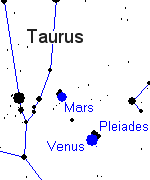
Image credit: NASA
The Pleiades are elusive. You rarely find them on purpose. They’re best seen out of the corner of your eye, a pretty little surprise that pops out of the night sky when you’re staring elsewhere.
Venus is just the opposite. Dazzling, bright enough to cast faint shadows, it beams down from the heavens and grabs you, mesmerizing. You can’t take your eyes off it.
This weekend, Venus and the Pleiades are coming together. It happens every 8 years: Venus glides through the Pleiades star cluster and, while dissimilar things don’t always go well together, these do. It’s going to be a beautiful ensemble.
Step outside after dark on Thursday, April 1st and look west. Venus is the improbably-bright “star” about halfway up the sky. Just above Venus lies the Pleiades, often mistaken for the Little Dipper because the faint stars of the Pleiades trace the shape of ? a little dipper.
If you go outside and look several nights in a row, you can see how fast Venus travels across the sky. On Friday, April 2nd, Venus enters the Pleiades, just below the dipper’s bowl. On Saturday, April 3rd, Venus scoots upward to join the stars in the dipper’s handle. On Sunday, April 4th, Venus exits the cluster altogether. Compared to what you saw on April 1st, the two have switched places.
Here are a few things to think about while you’re watching the show:
The Pleiades are a clutch of baby stars. They formed barely 100 million years ago, during the age of dinosaurs on Earth, from a collapsing cloud of interstellar gas. The biggest and brightest of the cluster are blue-white and about five times wider than our own sun.
The Pleiades didn’t exist when Venus first emerged from the protosolar nebula 4.5 billion years ago. No one knows what Venus was like in those early days of the solar system. It might have been lush, verdant, Earth-like. Today, though, it’s hellish. A runaway greenhouse effect on Venus has super-heated the planet to nearly 900? F, hot enough to melt lead. Dense gray clouds laced with sulfuric acid completely hide Venus’ surface from telescopes on Earth. The smothering clouds, it turns out, are excellent reflectors of sunlight, and that’s why Venus looks so bright.
As seen from Earth, Venus shines about 600 times brighter than Alcyone, the most luminous star in the Pleiades. During the weekend try scanning the group with binoculars. You’ll see dozens of faint Pleiades invisible to the unaided eye. Among them, bright Venus looks like a supernova.
But, really, it’s just an ancient planet gliding in front of some baby stars–a dissimilar ensemble that you won’t want to miss.
Original Source: NASA Science
